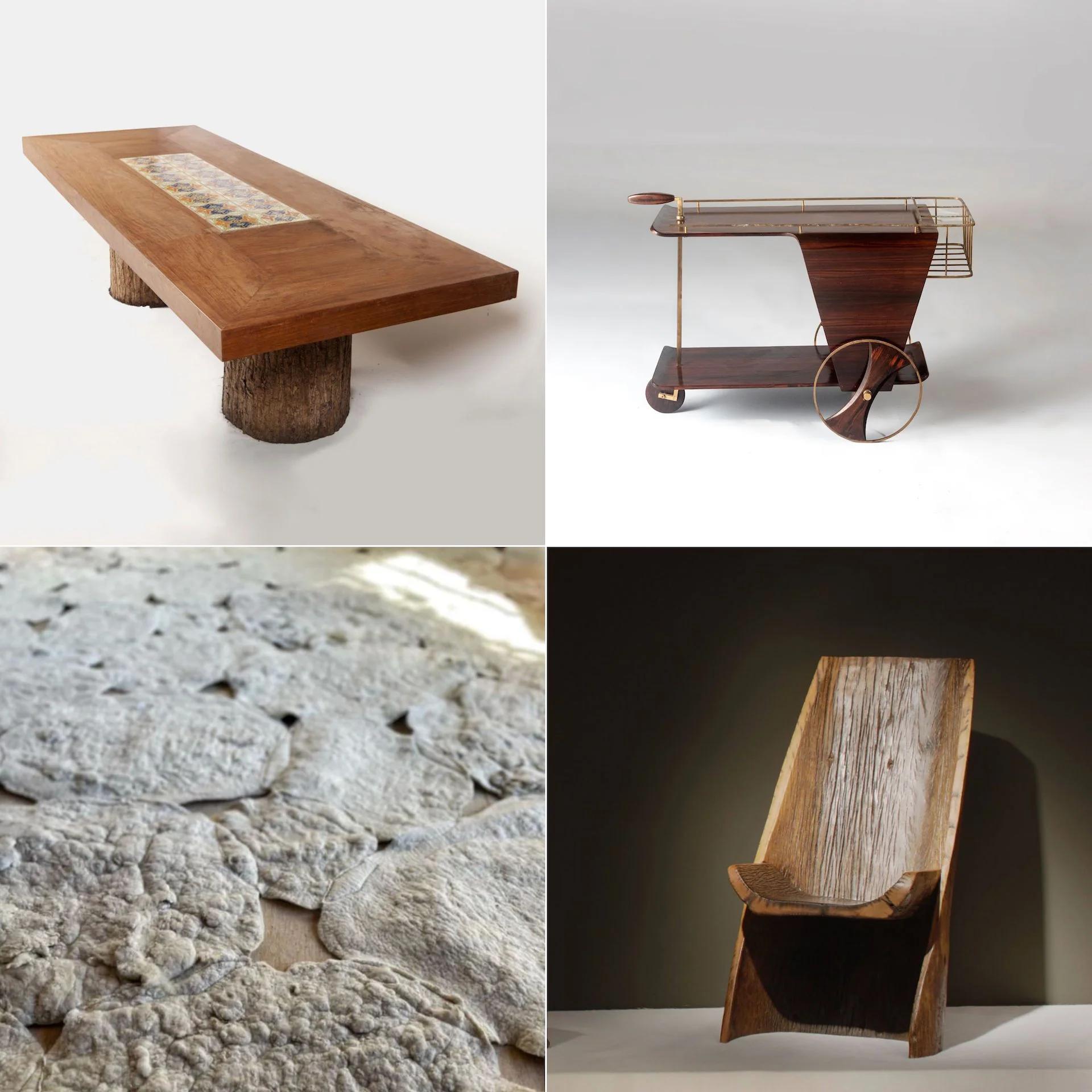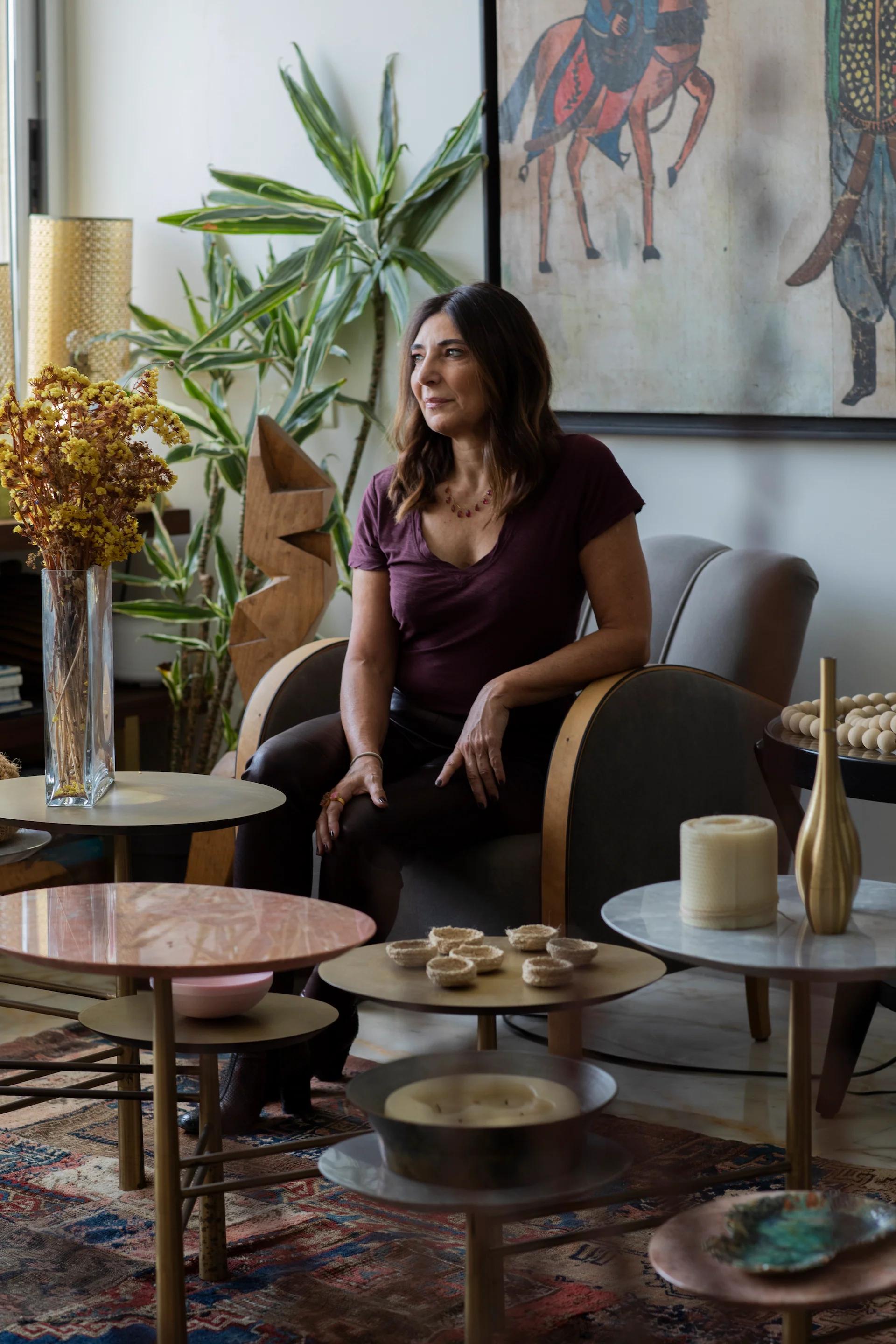CURRICULUM VITAE AUGUST 11 2023
by Wava Carpenter
Marcelo Vasconcellos of Mercado Moderno reflects on trailblazing the market for Brazilian design

JOSÉ ZANINE CALDAS/ OVAL TABLE, 1980
Photo © Mercado Moderno
As a diehard design historian, I’ve really enjoyed watching the collector market wake up to the uniquely rich and diverse production of Brazilian mid-century modernism. At Design Miami/ Basel 2006, I remember the budding curiosity that surrounded a handful of Joaquim Tenreiro pieces presented by New York’s R & Company. Around 10 years later, Brazilian design had become one of the hottest topics among the design cognoscenti; at the time though most English-language media continued to discuss visionary talents like José Zanine Caldas, Lina Bo Bardi, and their contemporaries as relative unknowns, and their work was frequently recommended to collectors as “a steal.”Cut to the last year or so, and Zanine’s massive, sculptural tables—hand carved in native South American woods and defined by “free-flowing, sensual curves,” in the apt words of legendary Brazilian architect Oscar Niemeyer—are fetching six figures at US and European auctions.
The phenomenal rise of Brazilian design’s valuation could not have been achieved without the dedicated efforts of Mercado Moderno, the Rio-based gallery founded in 2001 by Alberto Vicente, Rosana Vicente, and Marcelo Vasconcellos. The partners became international ambassadors for Brazilian Modern by a twist of fate, a chance opportunity to acquire a cache of discarded, wildly underappreciated furniture from a defunct local company. As similar opportunities followed, the trio became design history sleuths, tracking down lost documentation, conferring with designers’ families, and reconstituting forgotten archives. Along the way, they made their finds accessible to a much wider audience and helped build a robust global market. Today, Mercado Moderno is a go-to resource for serious collectors of both 20th and 21st-century Brazilian design objects.
We reached out to Vasconcellos to hear more about his gallery’s trailblazing path, what he’s most proud of, and which Brazilian designers remain undervalued.

LEFT: ALBERTO VICENTE (BACK) AND MARCELO VASCONCELLOS (FRONT) | TOP RIGHT: JOAQUIM TENREIRO/ CANED ARMCHAIRS, 1958. BOTTOM RIGHT: MÓVEL MODERNO BRASILEIRO / BRAZILIAN MODERN DESIGN, EDITED BY VICENTE AND VASCONCELLOS, 2017
Photos © Mercado Moderno
Design Miami/What prompted you and your partners to launch Mercado Moderno? What path led to the launch, and what was the vision?
Marcelo Vasconcellos/In the 1990s, we were already working with antiques, which was a very consolidated and competitive market at that time in Rio de Janeiro, and it was our habit to keep an eye out for new discoveries. When we came across a collection of modernist pieces from the headquarters of Editora Bloch—put up for auction after the company went bankrupt—we were immediately sure that that production, which was totally neglected at the time, had the potential to reach where it is today. It was then that we started to fully dedicate ourselves to promoting and selling Brazilian Modern design.

THE INTERIOR OF A HOUSE IN ITAIPAVA FEATURED IN MERCADO MODERNO'S BOOK, MÓVEL BRASILEIRO MODERNO, 2012
Photo © Mercado Moderno
DM/ How have you seen the international market for Brazilian Modern evolve over the last two decades, and which of the gallery’s contributions to this evolution are you most proud of?
MV/The international market for Brazilian Modern is experiencing its best phase to date. It has been integrated into important collections, is being sold by a large number of American and European galleries and auction houses, and has finally reached appropriate prices, consistent with the incredible quality of the pieces. And I believe that the best is yet to come!
Our greatest contribution was to see the value of Brazilian Modern furniture even when no one else did, and then to do the persistent work of participating in international fairs and publishing books on the subject—especially Móvel Brasileiro Moderno (2012) and Brazilian Modern Design (2017), among others.
When we started our research, there was very little literature written on the subject. Some architecture and interior design magazines addressed the theme, but it took many in-situ searches and a lot of oral history to begin to codify this production, which is now increasingly well documented nationally and internationally.

MERCADO MODERNO'S PRESENTATION OF WORKS BY ABRAHAM PALATNIK AT DESIGN MIAMI/ BASEL 2019
© Mercado Moderno
DM/ Can you spotlight some works from your collection and tell us what you love most about them?
MV/ The greatest treasure in our collection is for sure a group of works by Abraham Palatnik that we presented at Design Miami/ Basel 2019, which includes more than 20 objects collected over two decades. The artist's production, created in collaboration with his brother, was very limited—covering less than 10 years—and was totally handmade. His pieces in metal and hand-painted glass demonstrate his genius, which made him a recognized master of kinetic art. Whether for their rarity or their exceptional quality, we truly consider these pieces to be a treasure.
DM/For those who are new to collecting Brazilian Modern, where should they start?
MV/ Without a doubt, to start, one must understand the difference between a vintage piece and a reedition. A serious collection must also be guided by learning to identify the era’s woods and techniques—which along with good design principles are defining attributes that make Brazilian Modern so special.

DESIGNS BY BERNARDO FIGUEIREDO
Photos © Mercado Moderno
DM/Are there Brazilian Modern designers and makers that you feel remain under-appreciated?
MV/They exist, and we feel it is part of our responsibility to insist on correcting these deficiencies. Bernardo Figueiredo, for example, is a name that deserves more prominence than it currently has.
DM/ When considering contemporary designers for your program, what draws you to their work?
MV/In general, there must be some connection with modernist production—not necessarily in terms of aesthetics, as in the case of pieces by designer Gustavo Bittencourt, but perhaps in relation to the materials used, as in the case of Hugo França's production. In other situations, it’s precisely the contrast that creates a fresh and attractive way of presenting already known designs. The exquisite wool pieces by Inês Schertel and the psychedelic neon lights by Alê Jordão coexist gracefully with the elegant lines of Joaquim Tenreiro.

JOSÉ ZANINE CALDAS/ DENÚNCIA SERIES DINING TABLE, 1960 | MÓVEIS NOVO RUMO TEA CART, 1950S | INÊS SCHERTEL/ LANUDO RUG, 2022 | HUGO FRANÇA/ AZIZA ARMCHAIR, 2012
Photos © Mercado Moderno
DM/If you could live in any architectural setting built in the 20th century, which would you choose and why?
MV/ I am most attracted to a well-resolved project in which nothing is frivolous, whether by a renowned architect or not. I would love to live in one of the buildings designed by Vilanova Artigas, Sérgio Bernardes, Delfim Amorim, or Roberto Aflalo from Estúdio Branco & Preto.
DM/ Do you have a favorite work of design that you live with everyday?
MV/ Learning to let go is key for a professional dealer, otherwise you become a competitor to your best customers. However, there is a single work by an unknown author, which has been inside the gallery for over 20 years, since the first day. It has practically become a kind of talisman, and I hope to keep having it “watching” me for a long time!
DM/What is the gallery working on next?
MV/Continuing to expand our operations in Europe and the USA. The consolidation of Brazilian Modern in the international market has shown that this is a must for us.
You can follow Mercado Moderno on Instagram @memobrasil.


